Have you ever been in a situation where you’re prepared for an opening scene and instead meet a Samsung TV black screen? Under such circumstances, many queries, such as whether it is a minor glitch or something more serious, might arise instantly. Ultimately, this sudden interruption creates unnecessary stress and disturbance in the moment of leisure you once imagined having.
The importance of addressing this issue extends far beyond simple inconvenience because your TV isn’t just an entertainment device. Considering it a serious obstacle, the guide below provides a comprehensive solution with guided tutorials to help you get sorted.
Table of Contents
Part 1. What the “Black Screen” Issue Means on Samsung TVs
A black screen on a Samsung TV is an unsettling condition where the device is powered on, but the screen refuses to display visuals. For a better understanding, have a look at the most common scenarios in which the black screen issue appears:
- Complete Black Screen (TV On but No Picture): In this situation, the TV powers on, the indicator light works, but the display remains completely dark. This often points to issues with internal components, such as loose cable connections or a faulty power supply.
- Half-Black Screen (Panel or Backlight-Related): Another occurrence is when only half of the screen goes dark, while the other half remains visible and displays content. This “split view” issue is typically associated with backlight malfunctions, panel defects, or internal circuitry issues.
- Black Screen with Sound Still Working: Perhaps it's one of the most stressful cases when the TV produces sound but shows no picture. You can hear the dialogue and music from your show, but the visuals are missing, pointing towards a display panel issue.
Part 2. Why Samsung TVs Often Face Black Screen Problems
To address this dreaded Samsung TV black screen of death issue, you’ll need to figure out the reasons behind this issue first:
- Loose or Faulty Cable Connections: HDMI cables, in particular, are responsible for transmitting video and audio signals from external devices. When the wires aren’t inserted properly or aren’t compatible with your TV, the signal might cut off.
- Power Supply Issues: Once the power supply board fails, your screen may remain dark, though the standby light turns on. Inconsistent power can also cause the TV to turn on and off abruptly, an early warning sign of this issue.
- Backlight Malfunction Problem: When Samsung LEDs fail, the display can go completely dark while sound continues to function normally. It is even noted that the failure is partial, causing dim areas or a half-screen blackout.
- Unexpected Software Glitches or Firmware Errors: Since Samsung TVs function as smart devices, they depend heavily on software and firmware updates. Any sudden glitch, incomplete update, or corrupted system can interfere with display functions, leaving a black screen.
- Unusual Hardware Damage: Exposure to moisture, excessive heat, and accidental drops can damage sensitive internal components of your Samsung TV.
Part 3. Quick Checks to Fix a Samsung TV Black Screen
Often, what appears to be a Samsung television black screen can be caused by minor, easily fixable issues. That is why performing the provided quick checks not only saves time but also prevents unnecessary repair costs:
1. Ensuring Proper Power Connection
Power interruptions are proven to be one of the most common reasons behind a sudden black screen on a Samsung TV. To overcome this, connect the TV directly to a reliable wall outlet and eliminate hidden power inconsistencies for a stable power supply. After making a connection, wait for 1-2 minutes before turning the TV back on, allowing the internal circuits to discharge and refresh.
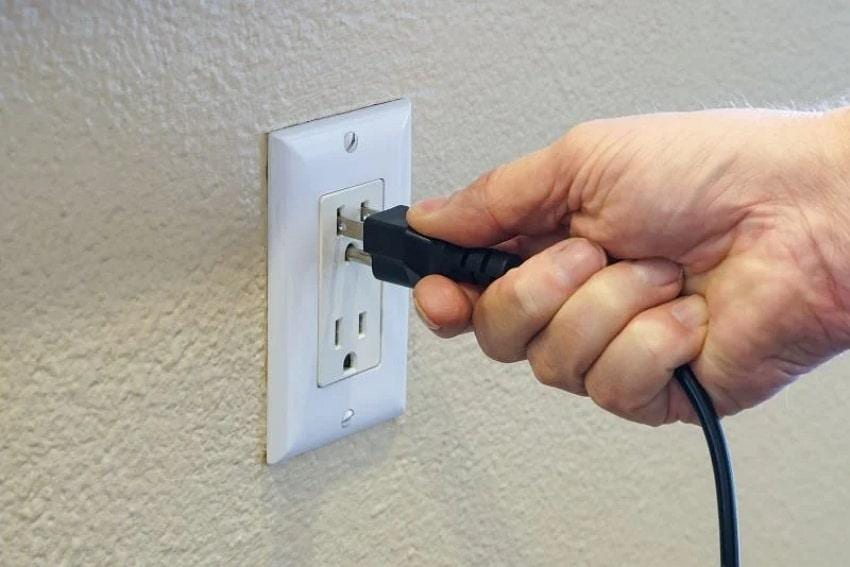
2. Checking The Remote Control and Power Button Response
Periodically, it is noticed that the issue isn't always with the TV itself but with how it's being powered on. When you test the physical Power button on a TV, it ensures that the device is operational, whereas checking the remote verifies that commands are reaching the TV. This distinction helps determine whether the TV responds to the power button but not the remote, indicating that the problem is isolated to the remote.
3. Switching Input Sources to Test
A Samsung TV black screen problem is sometimes associated with incorrect input settings or external devices. For instance, if your TV is set to HDMI 2 while your cable box is connected to HDMI 1, the screen will naturally appear black. To switch between multiple external sources, Samsung TV offers 2 options: either via remote or without it. For more clarity, read the instructions and understand how to switch input sources:
Press the “Source” button on the TV remote > Move to the “Source” menu > Select the relevant input mode > Hit “Enter” to switch and test the source.
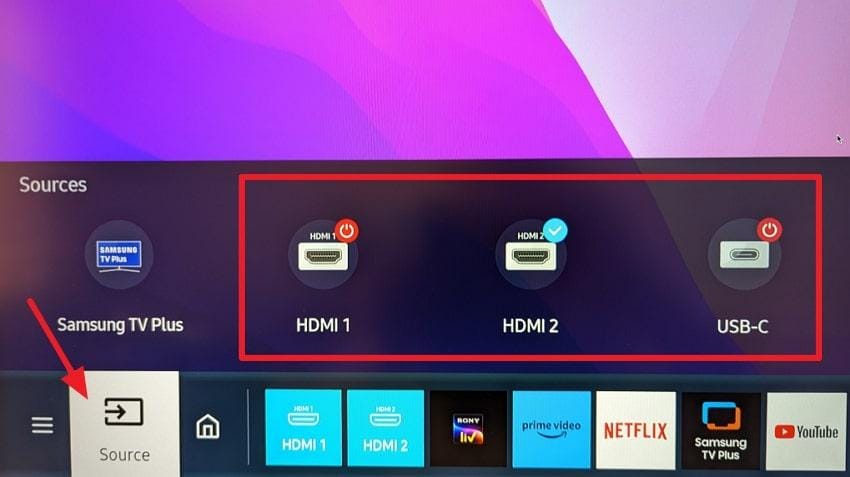
Part 4. Fixing Samsung TV Black Screen with HDMI & External Devices
Even after performing quick checks, a constant black screen on my Samsung TV now requires the provided HDMI and external devices fixes:
1. Reconnect HDMI Or AV Cables
Usually, HDMI and AV cables can loosen due to frequent use, vibrations, or even the simple act of moving the TV slightly. A partially connected cable may still provide sound but fail to deliver video, ultimately producing a black screen. If you simply remove and reconnect the HDMI or AV cables, you can restore the connection between the TV and external devices without further intervention.
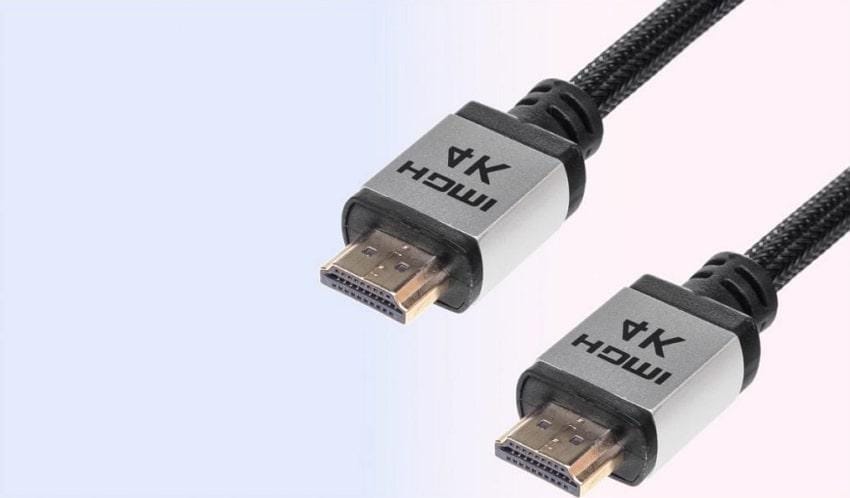
2. Test With a Different Cable or Device
Premium HDMI cables can also deteriorate over time, resulting in weak or no signal transmission on the Samsung TV. Likewise, external devices such as consoles may develop faults that prevent video from being displayed on the TV. Simply try a new console or switch to a different device to distinguish whether the issue lies within the accessories or the TV itself.
3. Enable The Correct Input Source in Settings
A blank screen on a Samsung TV can be caused by something as simple as the TV being set to the wrong input source. After switching input sources, if the screen remains black, you can enable and choose the correct source through External Device Manager settings. This assurance of the correct source allows the Samsung TV to receive and display video signals accurately. Follow the given guidelines to specify the correct input source in settings:
Step 1. Access the Samsung TV “Settings” menu > Choose the “General” option > Scroll down for the “External Device Manager” option.
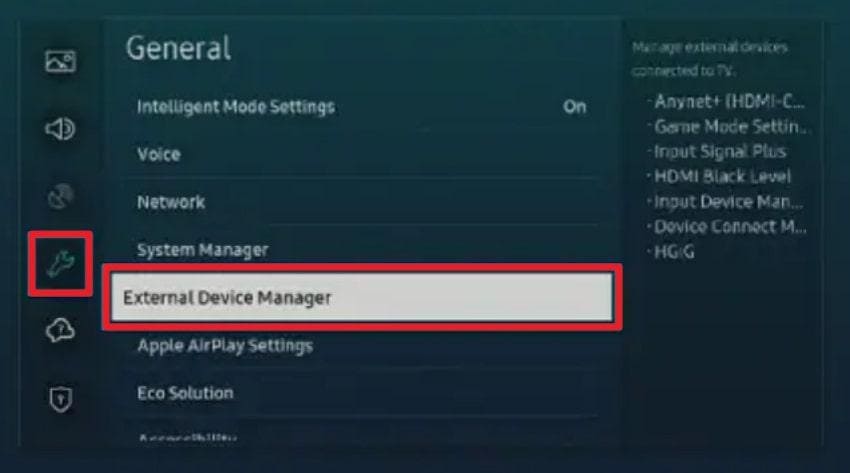
Step 2. Once done, select the “Input Signal Plus” option and enable the correct HDMI input source from the possibilities.
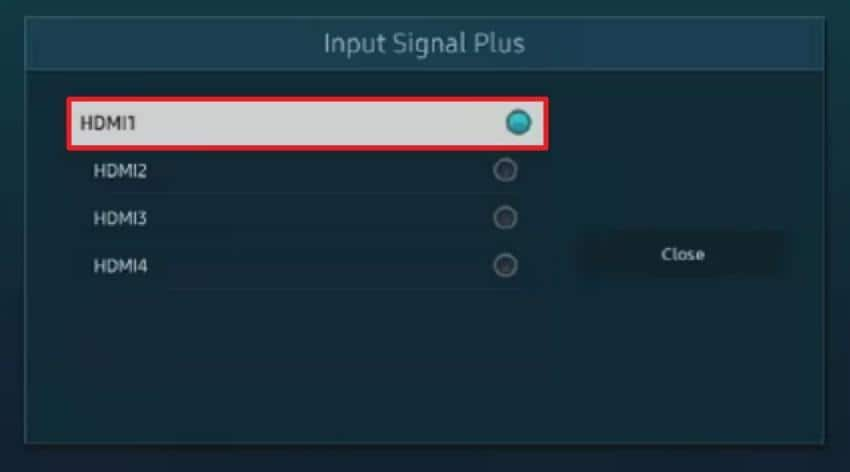
Part 5. Fixing Samsung TV Black Screen via Settings Adjustments
For constant thought of my Samsung TV screen is black, a more in-depth troubleshooting measure is needed via setting adjustments. Thankfully, making adjustments to the provided settings can often bring the display back without hardware repair:
1. Perform a Soft Reset of the TV
To give your Samsung TV a quick refresh without affecting any of your installed apps or downloads, consider performing a soft reset. Disconnecting it entirely from the power source allows the internal memory to clear and the system to restart in a stable state. Once the TV is unplugged from the wall outlet, leave it for 60 seconds to ensure that all residual electricity has drained from the capacitors.
2. Update Samsung TV Firmware
Think of firmware as the brain of your Samsung TV; it controls how the hardware and software work together. If it's outdated, the TV might struggle to handle newer apps or external devices, which eventually leads to a Samsung TV black screen. That is why updating your TV’s firmware is essential, as it not only improves compatibility but also strengthens system stability. To proceed, follow the tutorial for the Samsung TV firmware update:
Step 1. Turn on the Samsung TV through the "Power” button, access the “Settings” option, and choose the “Support” option.
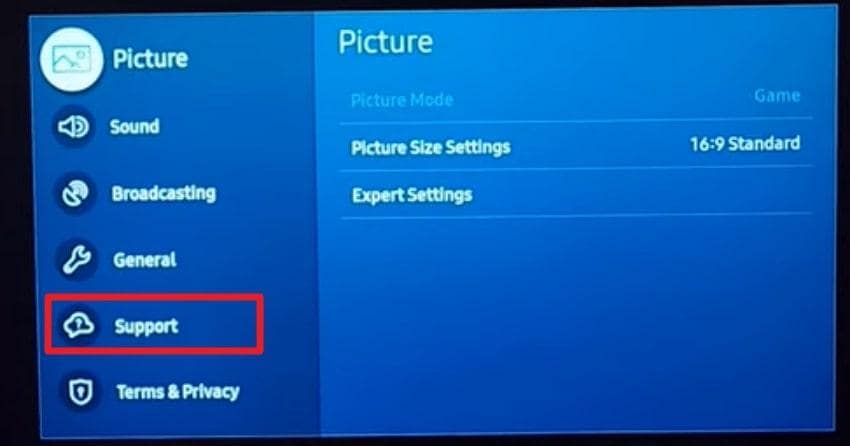
Step 2. From the Support window, press the “Software Update” option to get the latest version installed.
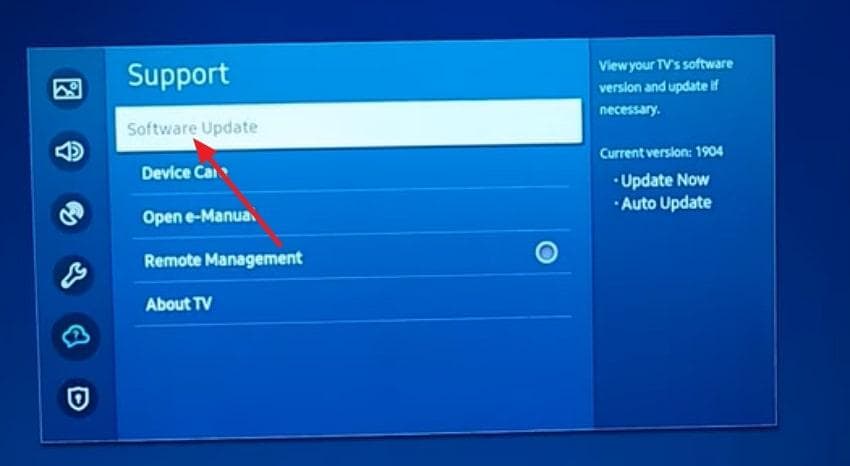
Step 3. Finally, hit the “Update Now” option and start installing the latest firmware for your Samsung TV.
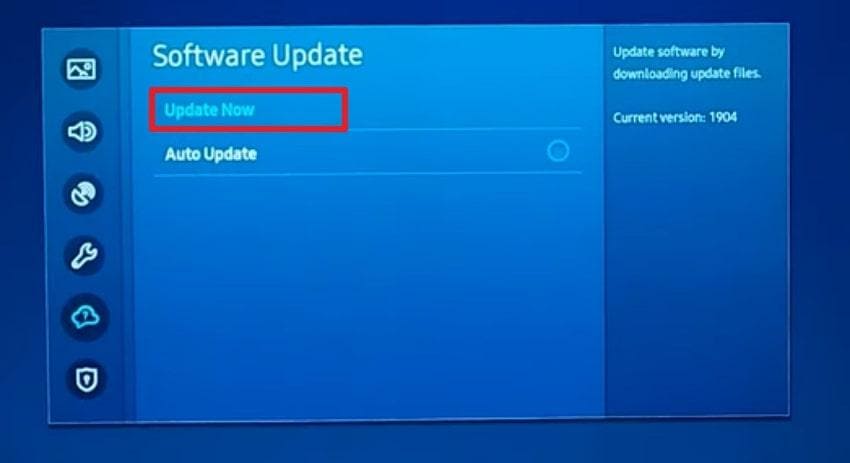
3. Run a Picture Test from Settings
The Picture Test is Samsung's built-in diagnostic tool, designed to identify whether the problem lies inside the TV or with connected devices. If the set of test images displays correctly, it means your panel and internal system functions properly, while the issue lies with the cables. Alternatively, if the screen stays black during the test, this strongly suggests an internal hardware issue. Explore the guidelines and run a picture test for the black screen issue:
Step 1. Enter Settings of your Samsung TV > Access the “Support” option and choose the “Self-Diagnosis” option to proceed.
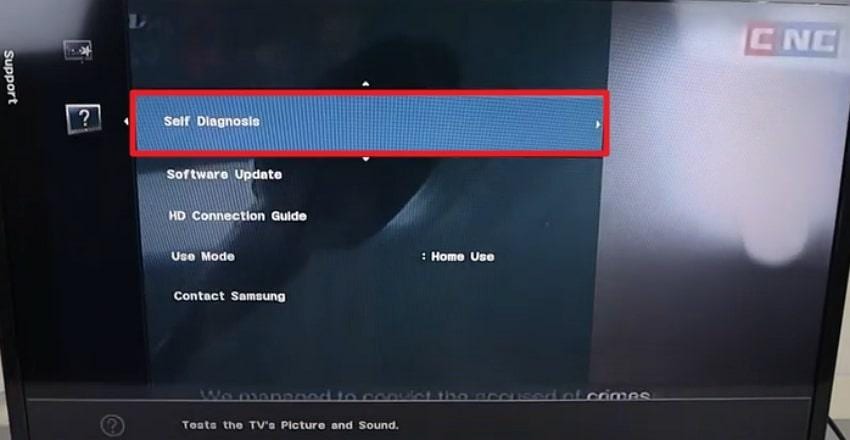
Step 2. After this, select the “Picture Test” option > Allow the TV to display test images > Follow on-screen instructions to complete the diagnosis.
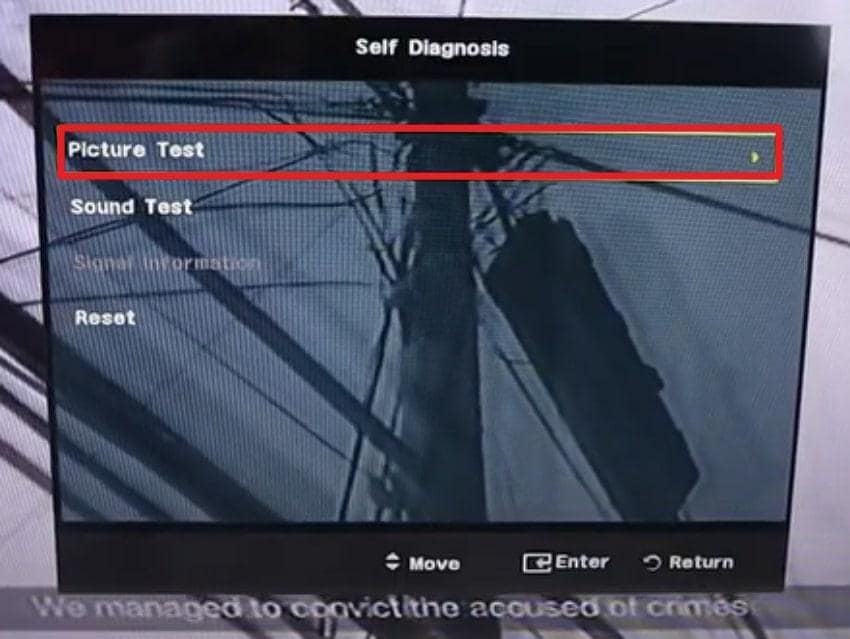
Part 6. Advanced Fixes for a Persistent Samsung TV Black Screen
If you’re still stuck on a black screen on a Samsung TV, head to the following section for more advanced fixes this time:
1. Perform a Factory Reset
Factory reset is often considered the “last resort” for software-related problems, but it can be surprisingly effective in black screen issues. Unlike a soft reset, a factory reset eliminates everything, including saved preferences, downloaded apps, and custom settings. This is important if the black screen was caused by corrupted system files or misconfigured settings that are interfering with the TV’s performance. Follow the manual and learn how to perform a factory reset:
Step 1. Press the “Home” button on your remote > Choose the “Settings” option and look for the “All Settings” option.
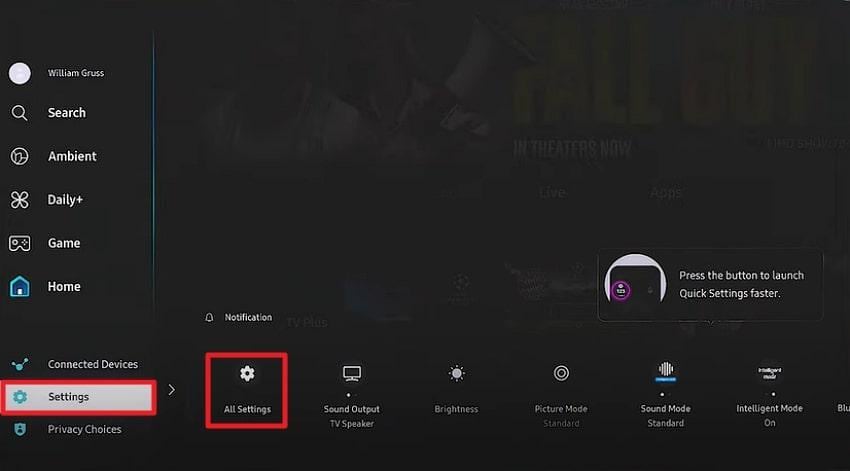
Step 2. Next, select the “General and Privacy” option and press the “Factory Data Reset” option to enter your default PIN.
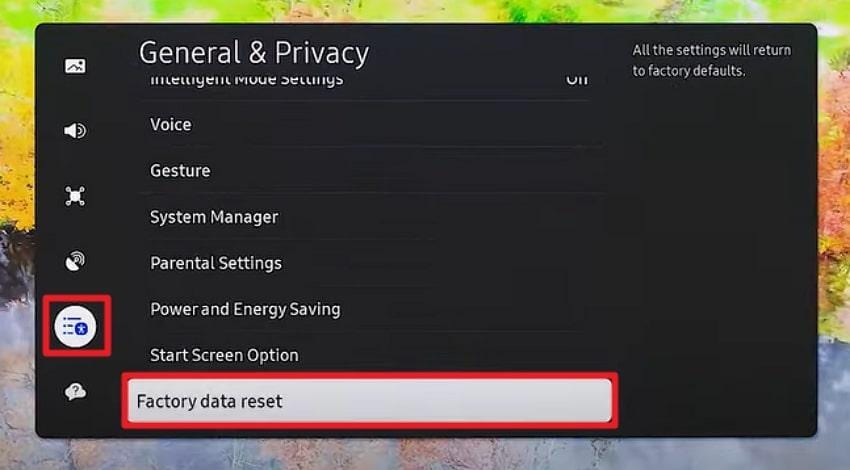
Step 3. Lastly, press the “Reset” option to confirm the action and perform a factory reset on the Samsung TV.
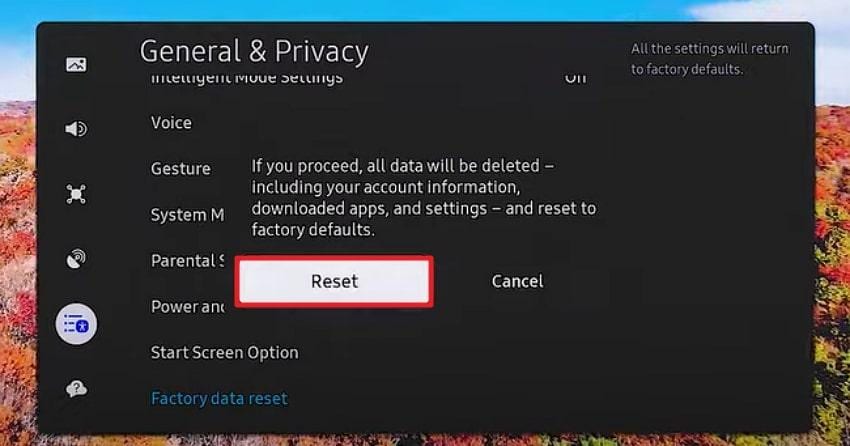
2. Check The Backlight and Hardware Components
For instance, the TV powers on, but the screen remains black; the issue might be with your backlight or internal hardware, like the T-CON board. The backlight is responsible for illuminating the display, while the T-CON board processes and delivers images to the screen.
To address this, you’ll need to examine these components and confirm whether the issue is purely hardware-related. Although this approach may require professional assistance, identifying the fault can take time.
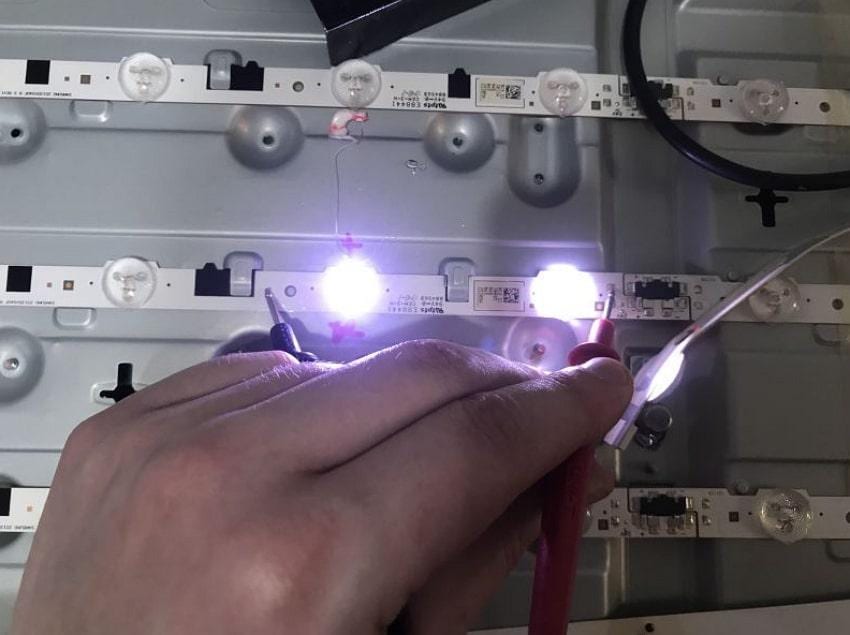
3. Contact Samsung Support for Hardware Repair
Contacting Samsung Support is the last resort when everything else fails, as it ensures that your TV is diagnosed and repaired by professionals. Some issues, such as a damaged power supply board or a defective panel, require advanced expertise that can't be fixed at home. An official repair for a Samsung TV half black screen requires visiting the official Samsung support website or the nearest authorized repair center.
Pro Tip: When the Issue Is with Corrupted Videos, Not the TV
Not every Samsung TV black screen or black screen of death is caused by a faulty display or cable issue. In some cases, the problem comes from the video file itself. If a video is corrupted or improperly encoded, it will stay black no matter how many times you try to play it — even if your TV works perfectly.
When that happens, the most effective solution is to repair the damaged file before playing it again. Repairit Video Repair is a powerful AI-driven tool that restores corrupted or unplayable videos to their original quality. Whether the file fails to load, plays with a black screen, or shows only partial visuals, Repairit can bring it back to life in just a few clicks.
Key Features
- Repairs Black or Unplayable Videos: Fixes videos that display a blank or black screen during playback due to data corruption or transfer errors.
- Multi-Format Support: Compatible with all major and professional formats (MP4, MOV, M2TS, MKV, etc.), ensuring seamless repair for videos from cameras, phones, or storage drives.
- Advanced Repair Mode: Uses a working sample file to repair severely corrupted videos and reconstruct their original structure.
If your Samsung TV screen goes black only when playing certain files — or if you experience a half black screen during playback — the video itself might be at fault. Repair it quickly with Repairit Video Repair, then enjoy your content again without interruptions.
Step 1. To do so, access the “Video Repair” section and press the “Start” button to insert your corrupted videos for repair.
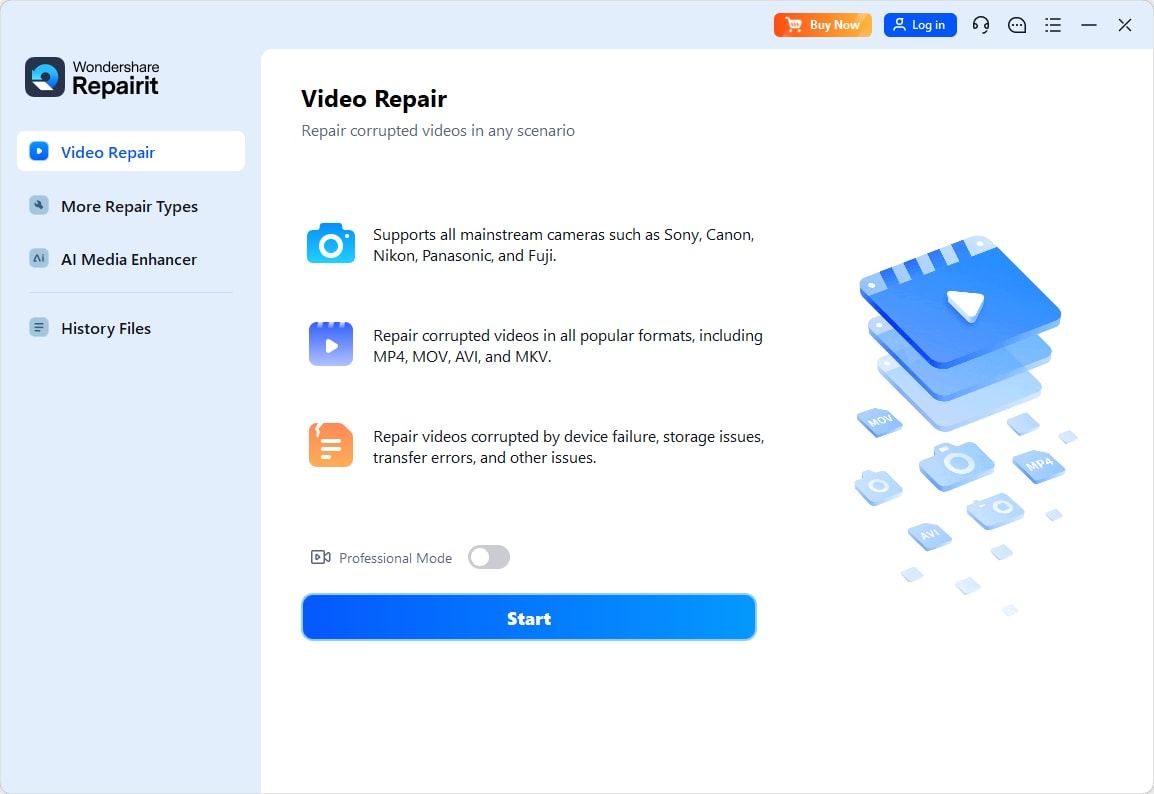
Step 2. Once done, hit the “Repair” button and get all your corrupted videos repaired for a smooth playback later.
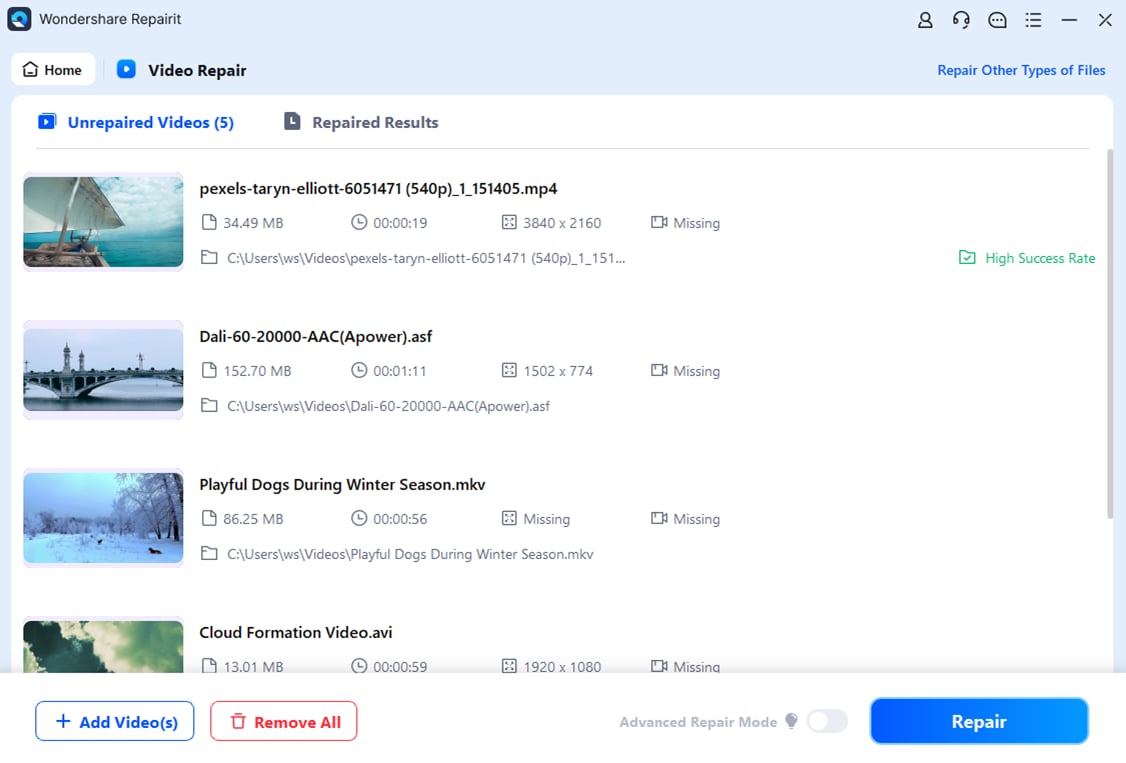
Conclusion
In summary, a Samsung TV black screen can be both inconvenient and concerning, especially when it leaves you wondering about the cause. It’s worth remembering that the source of the problem could be a corrupted video, which requires Repairit to be used extensively. Overall, before assuming the worst, consider both angles: check your television carefully, and don’t overlook the role of your video files.
Frequently Asked Questions
-
Q1. Why does my Samsung TV turn on, but the screen is black?
This usually happens when the TV is receiving power but is unable to display visuals. Common causes might include loose or faulty HDMI connections, T-CON board issues, or even software glitches. -
Q2. What does the Samsung TV “black screen of death” mean?
The Samsung TV black screen of death refers to a situation where the television turns on but shows no picture at all. It can be activated by hardware failures (such as a defective power supply board) or faulty external devices connected to the TV. -
Q3. How do I fix a Samsung TV with half black screen?
A black screen on a Samsung TV, even partially, often indicates hardware-related issues, such as backlight problems or a failing display panel. To troubleshoot, first try basic steps like disconnecting and reconnecting all cables, performing a soft reset, and running a Picture Test.


 ChatGPT
ChatGPT
 Perplexity
Perplexity
 Google AI Mode
Google AI Mode
 Grok
Grok

